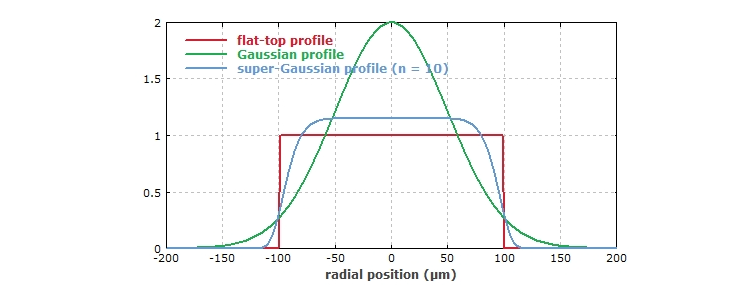Flat-top beams
2024-2-4
Definition:
The beam has a flat intensity cross-section.
A flat-top beam refers to a laser beam (usually a converted laser beam) whose intensity cross-section is flat over a large area. This is different from a Gaussian beam, where the intensity of a Gaussian beam decreases gently from a maximum value outward along the beam axis to 0. This type of beam is required in some laser applications.
For example, when processing semiconductor wafers or other materials, constant intensity is required in certain areas. In addition, in the nonlinear frequency conversion process at high power, the efficiency will be higher if a flat-top beam is used. In general, flat-top beams have smooth edges and can therefore be approximated as super-Gaussian rather than rectangular.

Figure 1: Flat-top beam (red) compared to Gaussian beam (green) and super-Gaussian intensity distribution (blue). The three light beams have the same power and the same effective mode area.
Flat-top beam propagation
Unlike Gaussian beams, flat-top beams are not free-space modes. That is to say, when the beam propagates in free space, the intensity shape will change.
The steeper the edge of the intensity curve, the greater the change. Figure 2 is a simulation of the propagation of a beam with an initial super-Gaussian beam shape.

Figure 2: The evolution of a beam initially with a super-Gaussian shape propagating in free space. The beam is first compressed and then expanded, with very smooth edges.
The color selection in the above case is based on the premise that the colors are the same when the beam is axially saturated. In fact, as the beam expands, the intensity becomes smaller.
The change in beam shape is negligible in practical applications. For beams with larger diameters and less drastic edge changes, the size and shape are approximately constant.
The beam has a flat intensity cross-section.
A flat-top beam refers to a laser beam (usually a converted laser beam) whose intensity cross-section is flat over a large area. This is different from a Gaussian beam, where the intensity of a Gaussian beam decreases gently from a maximum value outward along the beam axis to 0. This type of beam is required in some laser applications.
For example, when processing semiconductor wafers or other materials, constant intensity is required in certain areas. In addition, in the nonlinear frequency conversion process at high power, the efficiency will be higher if a flat-top beam is used. In general, flat-top beams have smooth edges and can therefore be approximated as super-Gaussian rather than rectangular.

Figure 1: Flat-top beam (red) compared to Gaussian beam (green) and super-Gaussian intensity distribution (blue). The three light beams have the same power and the same effective mode area.
Flat-top beam propagation
Unlike Gaussian beams, flat-top beams are not free-space modes. That is to say, when the beam propagates in free space, the intensity shape will change.
The steeper the edge of the intensity curve, the greater the change. Figure 2 is a simulation of the propagation of a beam with an initial super-Gaussian beam shape.

Figure 2: The evolution of a beam initially with a super-Gaussian shape propagating in free space. The beam is first compressed and then expanded, with very smooth edges.
The color selection in the above case is based on the premise that the colors are the same when the beam is axially saturated. In fact, as the beam expands, the intensity becomes smaller.
The change in beam shape is negligible in practical applications. For beams with larger diameters and less drastic edge changes, the size and shape are approximately constant.

